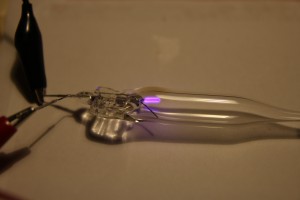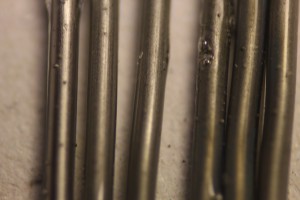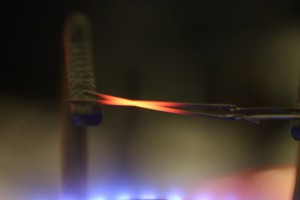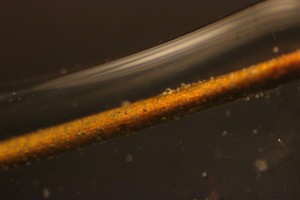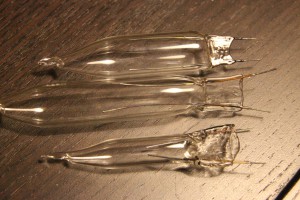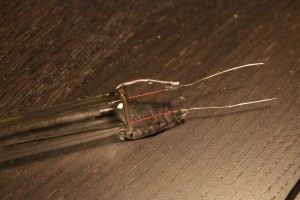Estimate reading time: 4 minutes
I spent last two weeks by making completely standalone argon tubes. I wanted to learn how to make a vacuum-tight feedthroughs and try to tip off the tube from filling system. I prepared a simple manifold for filling with argon, what turned out to be leaky, but I didn’t go for super purity gas and it was tight enough to tip off the tube. I am still waitingfor some glass components to make better manifold.. This experiment should also give some view of cathodic sputtering effect.
Kovar – boro seals
My first intention was to make a bulb using boro glass and kovar wire. Kovar is an alloy developed for sealing to boro glass. The wire should be degreased, then heated to 800-900ºC (red-orange color) and left at this temperature for several minutes. This procedure makes an oxide layer on the surface of the wire. The glass doesn’t adhere on the metallic surface itself, but wet the oxide and forms a strong seal. The seal should have gray color. Metallic color means too thin oxide layer (weak seal) and black color too thick – the glass could break off the wire (weak seal). I heated the wire for 5 minutes, this was enough. During this procedure the wire is also degassed from impurities (hydrogen, oxygen, carbon..), normally that time would not be enough (30 minutes is recommended), but because that wire is special for use in seals, I think it doesn’t contain too much of it. You could notice the bubbles from the wire trapped in glass when the wire contains too much impurities.
So, from 10 tries, I made only one good bulb – it was the first filled with air. Other (argon) were leaky and after sealing, the air get in in hour or two. I will try it again when I will have a oxy-gas torch, I used a oxy-air one. It should melt the glass enough to wet the wire sufficiently.
The bulb on the right is the only one working.. It was filled by air, after two hours of working without current limiting resistor (350V) it was covered by material sputtered from electrodes.
The leaky one, after an hour it would be dead..
oxidized kovar wire (0.41mm diameter)
in glass capillaries
too thin oxide layer on the left..
the glass doesn’t adhere well to the wires on the right, spot welded kovar to steel wires on the left
oxidizing the kovar in flame
Tungsten – boro seals
I didn’t want to use a tungsten for feedthroughs, because the wire itself may contain tiny cavities, this is because of how the wire is made.. But after failing with kovar, I tried it. I let the wire in flame for 2 minutes to form slight yellow oxide and than sealed. I made 3 bulbs and all are still tight (24 hours now). Tungsten is great material when working with flame, it is pretty hard even in hot flame, no worry about melting the wire..
Orange tungsten seal, glass pretty well covers the wire..
Dumet – lead glass
This is the killer combination, the seal is pretty even, without bubbles.. I like its purple color! But the annealing of this glass is much trickier..
 Nice seal, some bubble in the middle, but it is closed.
Nice seal, some bubble in the middle, but it is closed.
Conclusion – I will probably focus more on dumet – lead, because this way is pretty straightforward, the only disadvantage is more difficult annealing..
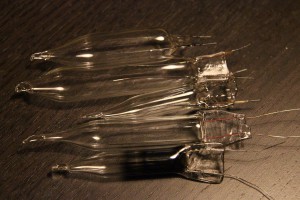 Working tubes, tungsten on the top (3 pcs), dumet, kovar on the bottom.
Working tubes, tungsten on the top (3 pcs), dumet, kovar on the bottom.
 under polariscope – boro glass on the top, lead glass on the bottom
under polariscope – boro glass on the top, lead glass on the bottom

